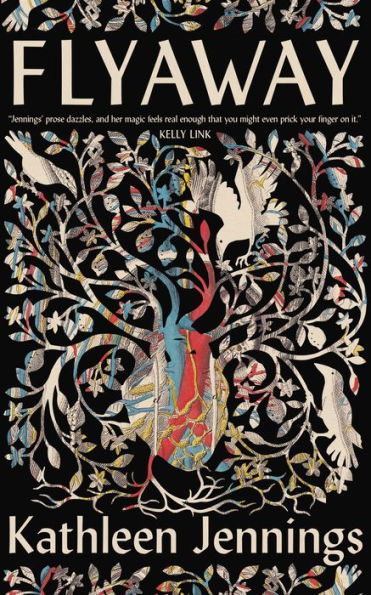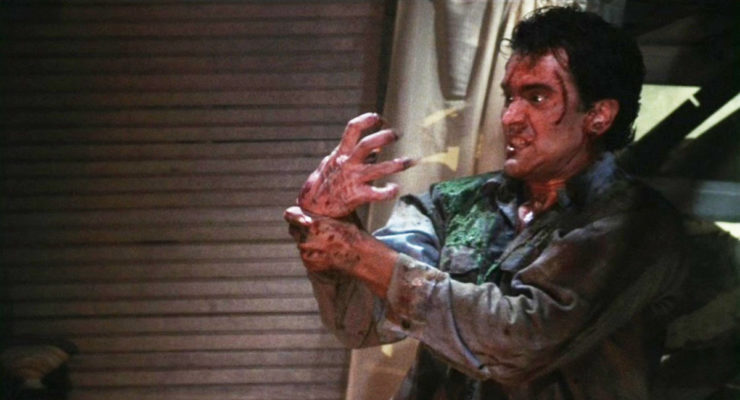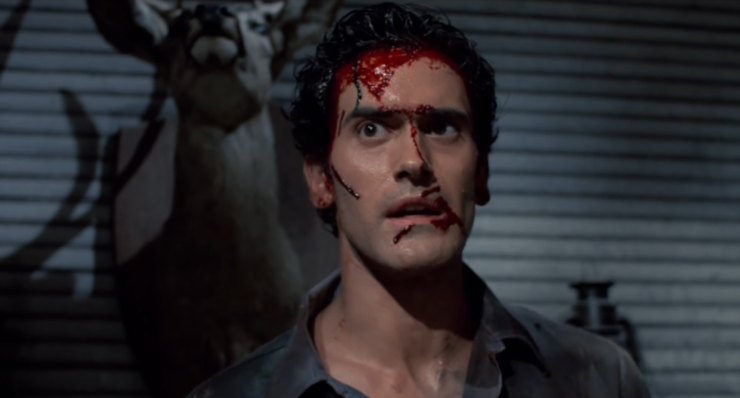Like much horror over the past 80 odd years, Sam Raimi’s Evil Dead films are indebted to H.P. Lovecraft. Evil Dead II in particular opens with intoned exposition about the Necronomicon. Lovecraft’s eldritch book is associated with madness and tentacular things that should not be. It’s also, as with most things Lovecraft, infected with the author’s racist loathing and terror of non-Western cultures. Supposedly written by a “Mad Arab,” the book within Lovecraft’s work links extradimensional eldritch evil with non-Western culture, tying them up together in a vile bow of cosmic terror and xenophobia.
Raimi isn’t a committed eugenic racist as Lovecraft was, but Lovecraft’s monstrous beliefs still snuffle and whisper around Raimi’s cheerful gorefest, whispering “Join us! Join us!” You can cast out the demons with an incantation, but there are uglier things in those woods that are harder to exorcize.
Evil Dead II is a remake rather than a sequel; its plot is essentially the same as that of its predecessor, The Evil Dead. The first movie was a scrappy indie production. The second is a studio film with ten times the budget, which means Raimi had enough money to at least briefly visualize his colonialist backstory.
Buy the Book


Flyaway
We get to see professor Raymond Knowby (John Peaks) on his expedition in some distant, nameless, non-Western land. He brings the Necronomicon back to a remote cabin in the woods for study, foolishly reads its opening incantation into a tape recorder, and summons a “Kandarian demon” which possesses his wife. When young dude Ash (Bruce Campbell) and his girlfriend Linda (Denise Bixler) sneak up to squat in the cabin overnight, they find the recorder, play it, summon the demon again, and then spend the rest of the film living with the consequences (madness, hideous dismemberment, buckets of disgusting fluids…you know the drill).
In line with Lovecraft’s predilections, then, the dead in the film are “evil” because they’re from over there, in some far colonial clime. Knowby is cursed for bringing that far evil back home. And the punishment for that desecration is to have one’s body and identity inhabited and expropriated, just as Knowby expropriated the book. The movie’s nightmare is a colonial reversal—the fear that they will do to us what we did to them. We have taken their stuff; now they will take our souls. The justice of that revenge is underlined by the fact that, unlike in the first film, many of the victims here are directly implicated in the crime. Knowby’s daughter, Annie (Sarah Berry) and her research partner Ed Getley (Richard Domeier) come to the cabin with additional pages of the book. Along with two local guides who lead them around a broken bridge, they end up prey for the deadites, just like Ash.
Lovecraft has a real visceral disgust at the prospect of racial and cultural mixing; Cthulhu’s inevitably non-white servants fill the author with a nameless dread. Raimi riffs on that fear; Evil Dead II is filled with geysers of blood, unnatural bloated walking corpses, and the terrifying shrieks of the damned.
Those shrieks are often hard to distinguish from laughter, though. Raimi borrows the corpse of Lovecraft’s hatred and fear, but he paints it in clownface. The major aesthetic the film evokes isn’t H.P.’s twisted, Cyclopean prose, but the gloriously heightened slapstick of Looney Tunes cartoons—much of Evil Dead II plays like Bugs Bunny with more ichor. The famous sequence where Ash’s hand is possessed is a sublime symphony of manic brutality, as Campbell staggers around the kitchen smashing himself in the head with plates, gripping his own hair and flipping himself over on the floor, and finally plunging a knife into his own hand while bellowing, “Who’s laughing now?! WHO’S LAUGHING NOW?!” The answer, of course, being everyone, because foam-flecked ranting about how you’ve defeated your own hand is pretty funny.

That hand isn’t that easy to defeat, though—it’s such a spunky underdog you almost end up rooting for it as it pulls Ash’s unconscious body along by its fingernails so it can grab a cleaver, muttering darkly to itself all the while. After Ash cuts it off, it scuttles into a mouse hole, as if the Tom and Jerry analogy weren’t clear enough. The other deadites are also oddly endearing, in their muck-encrusted, murderous way. Knowby’s wife, buried in the fruit cellar, bursts out of the ground with winning, manic glee, claymation worms writhing in her hair with a slimy exuberance. “I’ll swallow your soul! I’ll swallow your soul!” she burbles. When she reaches up through the chained cellar door and grabs hold of one of the hapless hillbilly locals, you have to cheer on her ingenuity and gumption, not to mention the valedictory spray of vile liquid as she devours her prey. Similarly, Linda is a bland, standard-issue, pleasant-looking Hollywood girlfriend as a human. As a deadite she’s filled with star-quality energy, dancing wildly in the moonlight with her own severed head.
To some degree, then, Lovecraft’s hatred of some vague, looming, non-white corrupter trying to crawl into Western culture is turned inside out, with all its bits pulsing. The dull white pilferers—stealing books like the professor, or squatting on someone else’s property like Ash and Linda—get what’s rightfully coming to them. “We are the things that were and shall be again!” a deadite howls. The indigenous people Lovecraft hated are going to get their revenge—and, not coincidentally, all the best lines.
By rights, Evil Dead II should end as the first film did—with Ash possessed and the deadites victorious. Unfortunately, Raimi had a sequel in mind, so there’s no such happy ending. Instead, Ash is granted heroic, stirring soundtrack cues as he cuts up the dead with his arm chainsaw. Knowby’s daughter reads the incantation to trap the demon on the physical plane as she dies, expiating her theft of the book in a final act of self-sacrifice. Ash forces the monster into the dimensional portal, and then is himself sucked into the Medieval past, there to take part in the related colonial genre of epic fantasy in the next movie, Army of Darkness.
None of this is to say that Evil Dead II is committed to a racist, colonial vision. On the contrary, it is to drive home the opposite: Raimi’s movie is a glorious goof, which picks up some of Lovecraft’s tossed-off ideas as an excuse for gross-out physical comedy and joyful filmmaking. But to the extent that a determinedly silly movie like Evil Dead II can have a moral, it’s that the things you borrow can haunt you.
Addendum: Some commenters have argued that the deadites can’t be non-Western, since the book is found in England. The Evil Dead films are notably (and even gleefully) loose about continuity, but it’s worth noting that the language of the book is supposed to be Sumerian.
Noah Berlatsky is the author of Wonder Woman: Bondage and Feminism in the Marston/Peter Comics (Rutgers University Press).










